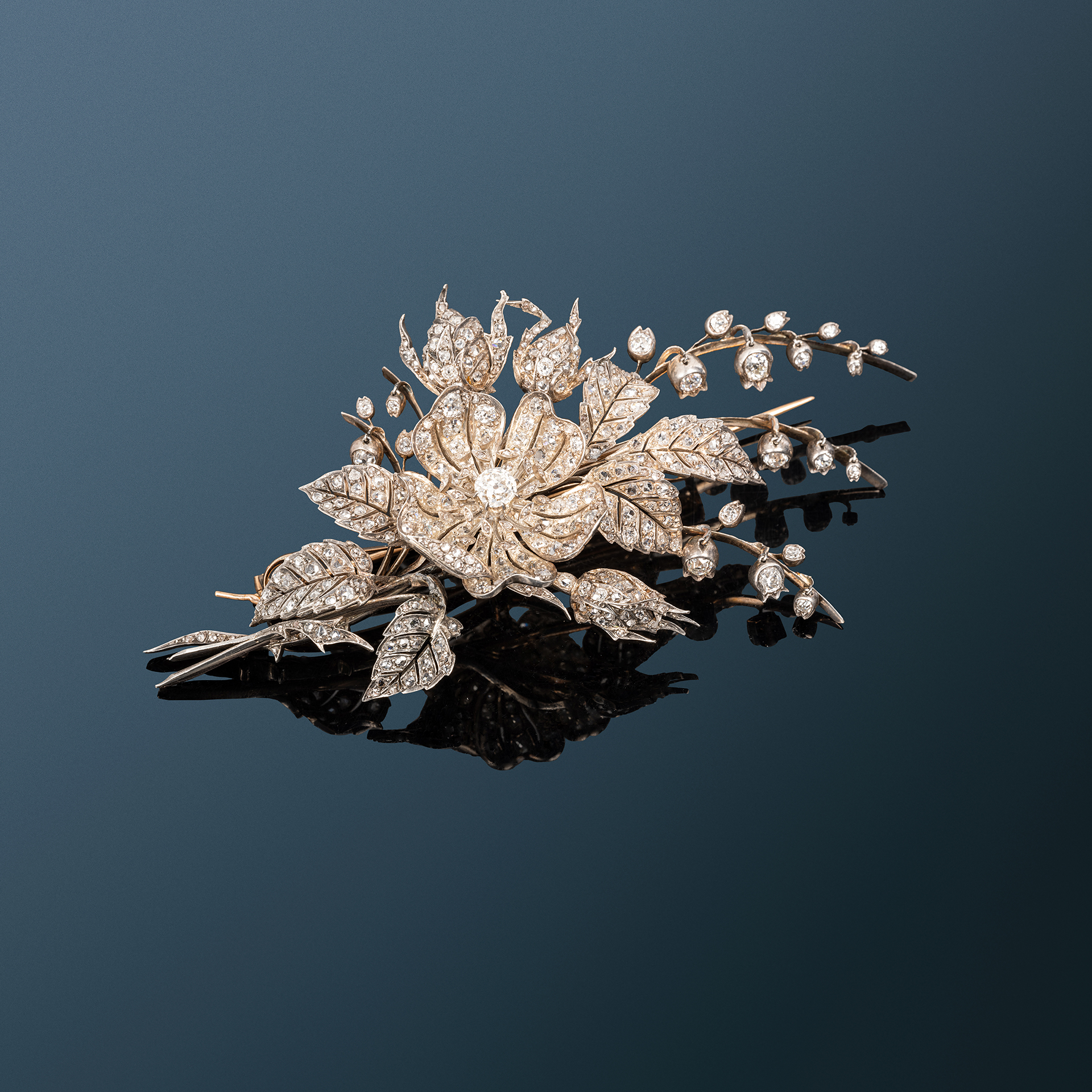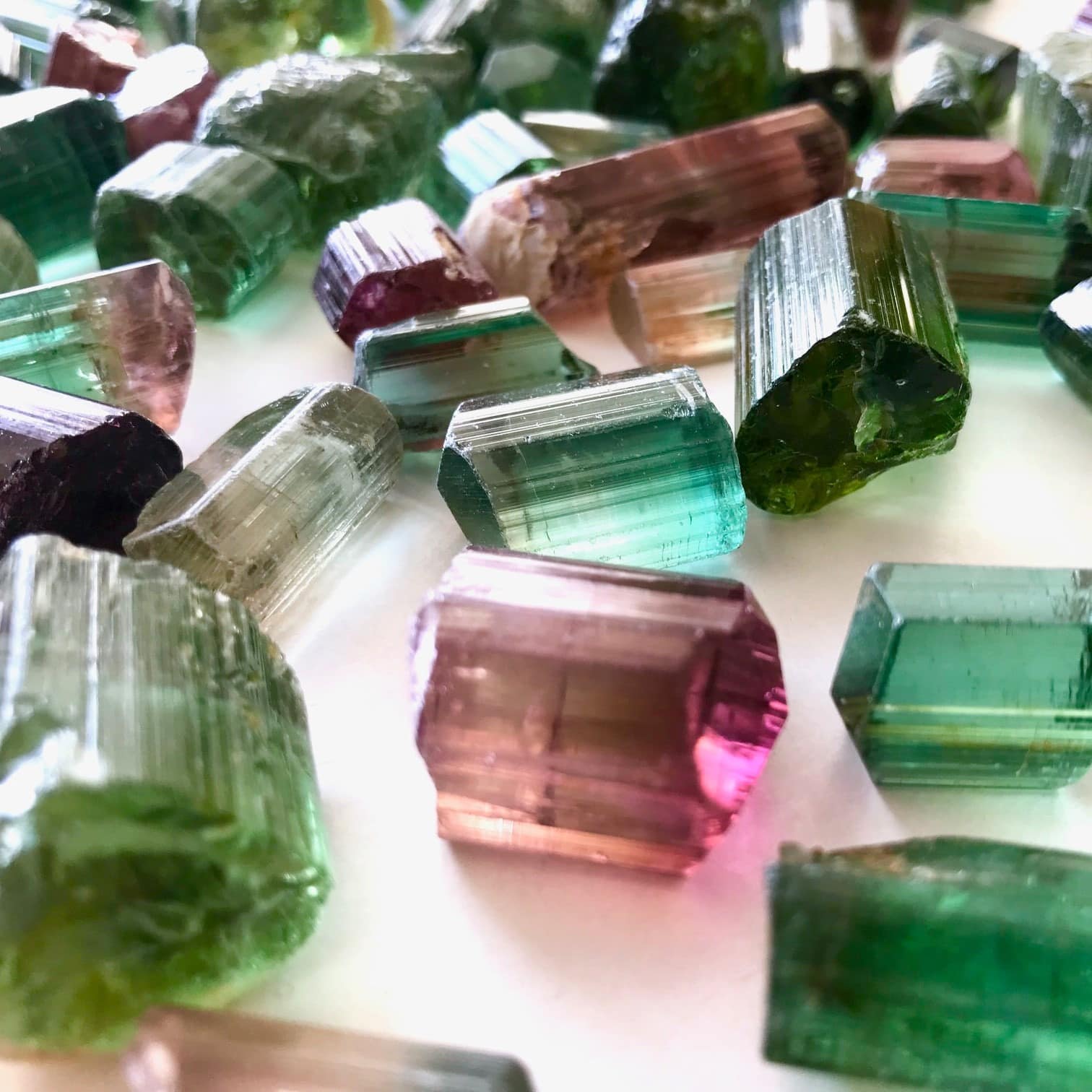Things are moving in the art market and in the field of expertise. And it’s moving in a good way! For a few months now, a young expertise firm has been making news. With a name that suits it like a glove and made up of three talents in the trade, the firm Sancy Expertise Paris operates in four specialities: jewellery, watches, goldsmiths and objects of virtue. Already, several fine auctions have been noted in auction houses such as Fraysse & Associés, Pierre Bergé & Associés and Coutau-Bégarie & Associés. We meet three experts with whom we will have to reckon: Drew Battaglia (jewellery), Maxime Charron (objets de vertus and Russian art) and Florian Doux (goldsmiths). Passion, professionalism and enthusiasm will be the order of the day!
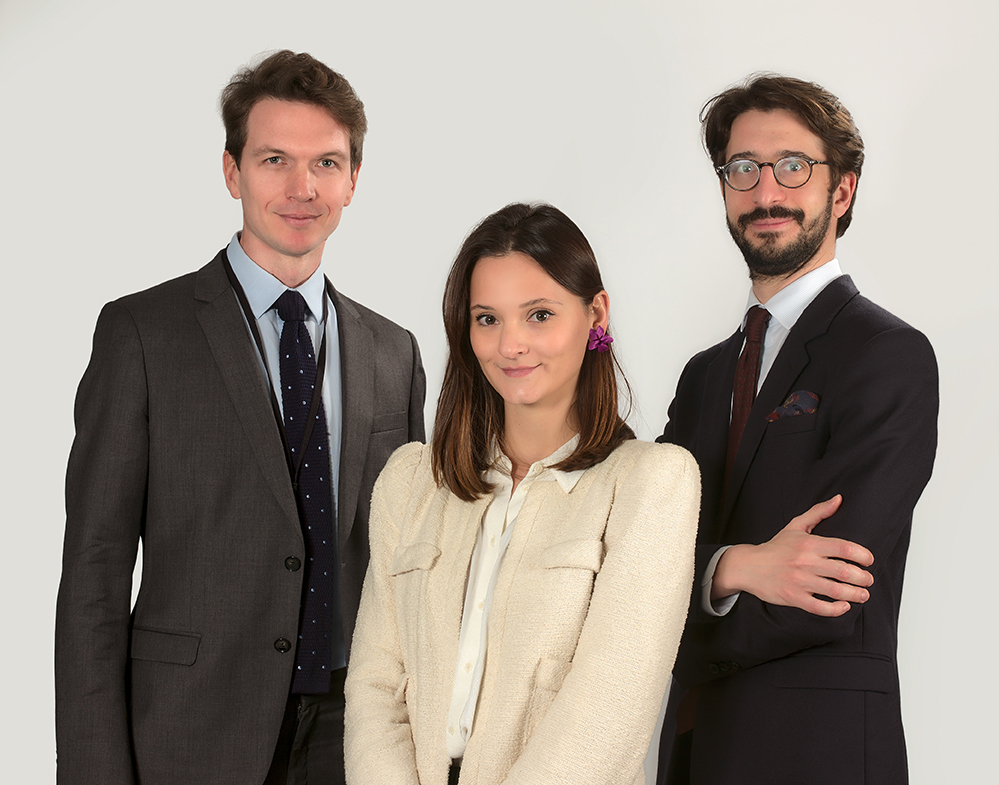
Maxime Charron, Drew Battaglia & Florian Doux. Photo: Sancy Expertise Paris
1- Can you tell us in a few lines the vocation and purpose of Sancy Expertise?
Maxime Charon: We are first and foremost an appraisal firm for jewellery, watches, silverware and display items for auctioneers. Then we have other activities such as inventories for estates and/or insurance companies as well as private sales.
Drew Battaglia : We are an expert appraisal firm for jewellery, watches, silverware and display items, serving private individuals to assist them with their sales, insurance or simply inventories. We want to diversify our expertise beyond auctions, even if this option remains the basis of our business.
Florian Doux: We wanted to create a firm that combined seriousness, competence and networking in an increasingly fragmented and disparate art market.
2- Why did you choose this name?
MC: We wanted the words “Expertise” and “Paris” to appear in order to directly target our activity and we think that it reassures the actors of our market to specify that we are established in the capital. “Sancy” was found afterwards because we are three people who are passionate about history and the history of objects.
DB: It was important to us that our name reflected our specialities in general and that it was serious. “Sancy” was an obvious choice. What could be better than a historic diamond, bought, sold, passed through several hands to represent an expertise firm. We then added “Expertise” and “Paris” to delimit our activity.
FD: We placed ourselves under the patronage of the Sancy diamond, bought by Mazarin and kept in the Louvre Museum. This choice was self-evident. We find different facets of our skills and backgrounds in it: knowledge and expertise of precious stones, a taste for historical objects, but also a nod to one of the members of the firm who worked at the Louvre for five years.
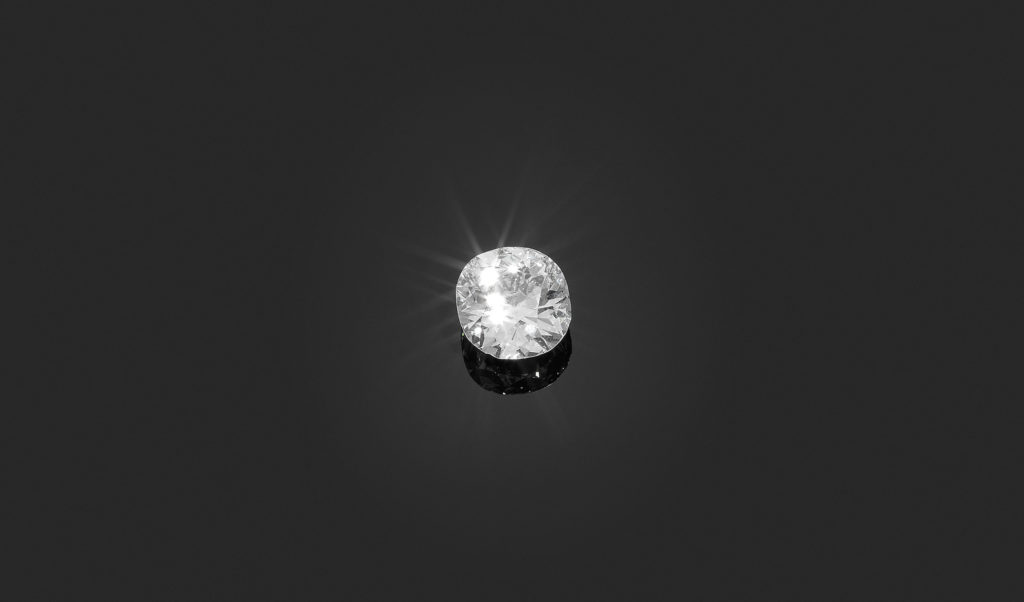
Gold ring set with a 20.52-carat cushion-cut diamond, H / VS2. Sold for 850 080€ at Fraysse & Associés on 7 April 2022.
3- What were your respective backgrounds before the creation of your firm?
MC: I graduated from the École du Louvre, then I was at Christie’s during the sale of Pierre Bergé & Yves Saint Laurent. I then joined the Coutau-Bégarie auction house where I was trained in the Russian Art and Historical Memorabilia department. In 2014 I set up my own gallery, Royal Provenance, which is now located at 5 rue Auber, 75009 and which will participate in the Tefaf in June 2022. At the same time, I am an expert for about fifty auction houses.
DB : After studying gemology and obtaining the GIA, I was hired by my first internship supervisor in an antique jewellery appraisal firm. I then became the assistant to the Paris office of the international dealer Faerber Collection before setting up my own business in 2022.
FD: I am an art historian and an expert and I have benefited from a double training. I have a bachelor’s degree in history, a bachelor’s degree in art history and two Master’s degrees in art history from the Sorbonne. I continued my studies at the Louvre Museum where I was recruited in 2017 to co-write the catalogue raisonné of the museum’s goldsmith’s collection. At the same time, I was trained by one of the best gallery owners specialised in silver and silverware at the Carré Rive Gauche, with whom I have been collaborating since 2015.
4- What made you want to start your own business? What does it bring you?
MC: It was the confidence of the auctioneers who worked with us even before the firm was created that encouraged us. The creation of the firm as a group of three brings us more strength than if we had worked individually. We believe and want to provide a real service that is not available on the market.
DB: After 10 years in the art market, I felt ready to take responsibility for appraisals. We felt that the art market was evolving, modernising, both in terms of new players and the way we work. All of this suited us. It is very stimulating. We were lucky to be followed by auctioneers who knew how we worked and who trusted us.
FD: My taste for objets d’art, and especially silverware, is old. There is a very particular pleasure in finding yourself in front of an object about which you know nothing and succeeding in identifying a date, a production context and sometimes even a patron. This very specific skill, this eye both of researcher and amateur, refined by my academic training and my weekends spent in flea markets and antique shops, naturally led me to expertise. This profession is a natural outlet for my interests but also a way to constantly confront myself with new objects, to broaden my field of competence to periods and styles to which I would not have spontaneously turned by myself.

Rare gold snuffbox by Vachette, 1794-1797, L’Apothéose de Bonaparte. Sold for 86360 € at Fraysse & Associés on 10 December 2021.
5- For you, what is “being an expert” and how can one keep this title?
MC: For me, being an expert means knowing the truth about an object (its authenticity, its historical context, its provenance, its value etc.). You keep this title by making as few mistakes as possible.
DB: For me, being an expert means having a feeling for an object and, thanks to one’s experience and culture, being able to explain what the object reveals. You can always make a mistake because you never know everything, which is why humility is the first step to keeping your title. I also think that it is very important to always be informed (new treatments, new markets, discoveries, culture, etc.).
FD: Being an expert means knowing both what to know and where to look. No one can claim to be omniscient, but through study and practice, one builds up a sort of mental database, a register of comparisons and references, which helps either to identify the piece, because one knows the hallmark or has already encountered the shape, or to restrict one’s field of research by eliminating everything that it is not.
6- What is the most outstanding piece (appraised or not) of your career?
MC: An iconic Russian triptych that I recently appraised and which was pre-empted by the Louvre Museum and sold for €130,000 at De Baecque. It was a very emotional and proud moment.
DB: I remember a silver and black lacquer bracelet by Raymond Templier that sold for €100,000 when I was an intern in an appraisal office. It may have been silver and circa 1930, but the design was timeless and terribly modern. It made an impression on me at the time because I was discovering this jeweller. A similar drawing is shown in the book on the artist, it’s always moving when that happens.
FD: In the Louvre there is a small silver torch in the pea pod style, from the early 17th century, the work of the Parisian silversmith François Roberdet. It is a rather simple object, far from the lavish and exuberant pieces of the second half of the century. However, its delicacy, the light and graceful elegance of its tendrils that wind around the bobèches, particularly touch me. Of course, I have not “appraised” it, but I was lucky enough to be able to study it for a long time in the Louvre when I was working on the catalogue of goldsmith’s and silversmith’s art.
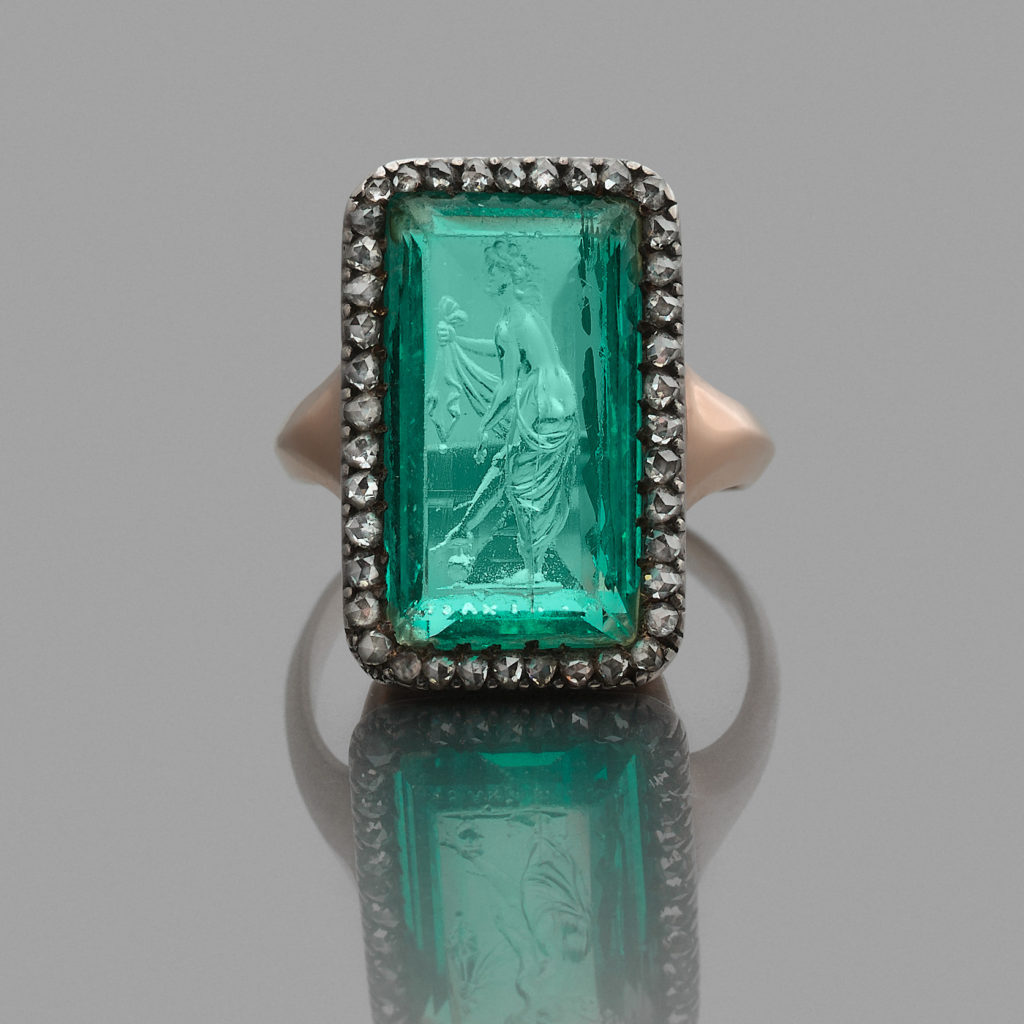
Luigi PICHLER (Rome, 1773-1854). A rare 18K (750) gold ring set with a rectangular cut emerald (approx. 5.50 ct), intaglio engraved representing Venus emerging from the bath, in a silver setting of rose-cut diamonds. Small chips. Circa 1810. Sold for 35,000 euros at Pierre Bergé & Associés on 2 June 2022.
7- I have objects at home, how can I show them to you and how much does it cost to have them appraised?
MC: Appraisals are free and confidential. Generally we offer to send us photos if the person is far away. The second step is to come and see them if necessary.
DB: We rely heavily on the responsiveness of our responses to requests for estimates. Depending on the possibilities and the urgency, we can give a first idea of an estimate based on photos and then refine it once the object is in hand. It is always better to see the object to be as accurate as possible but we try to adapt. We only charge for inventories for insurance and stock. Appraisals are free and confidential otherwise.
FD: You can contact me via the firm’s website to present the objects, either in photographs or by making an appointment.
8- How do you view the current art market? Are beautiful objects becoming rarer? How is it being renewed?
MC: Beautiful objects are not becoming scarce, but the art market is refocusing on important objects. There are more and more buyers all over the world, for example we are always surprised after a sale to see that there are at least 50% new buyers, including young people.
BF: I speak for my part but I have felt a real diversification of buyers. There are new players for a certain type of jewellery that wasn’t there before. The Covid crisis has allowed individuals to become more interested in auctions for example and has offered the market new buyers. I think (and hope) that the younger generation will follow suit with a new taste for antique jewellery.
FD: We are coming out of a rather difficult period. Covid was a sudden halt, and the various scandals linked to forgeries have caused the market to be somewhat cautious in certain areas. However, there is a real enthusiasm on the part of collectors to return to the auction rooms and, paradoxically, the heightened expectations of buyers in terms of the provenance of works reinforce the role of experts.
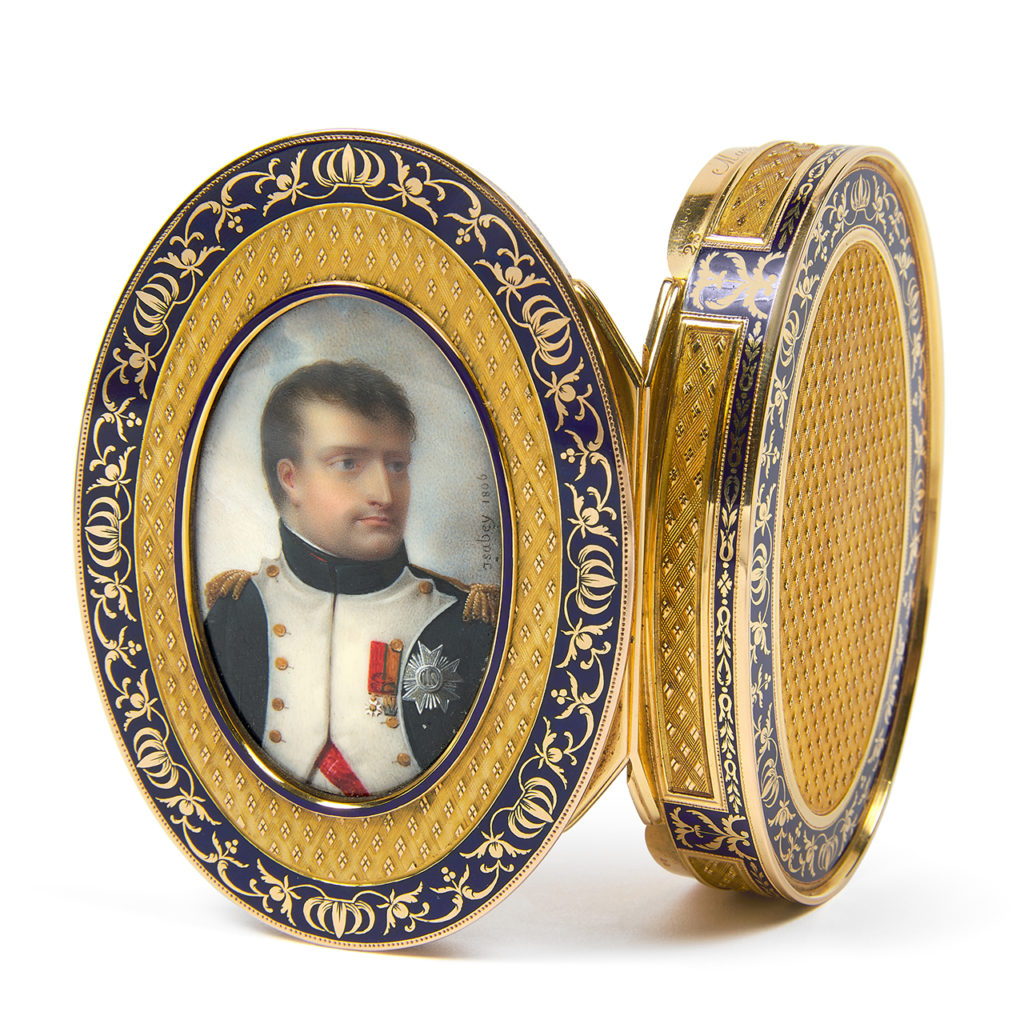
Gold and enamel snuffbox showing Napoleon in the uniform of a colonel of the Imperial Guard. By Étienne-Lucien BLERZY for MARGUERITE. The miniature by Jean-Baptiste ISABEY. Sold for 85,000 € at Fraysse & Associés on May 11th 2002.
9- How do you keep the passion and let yourself be moved by an object?
MC: A passion never really dies out. It is because I am still passionate that I remain moved. And above all, we are lucky enough to live in a profession of surprises and to never know what we will come across in our inventory.
DB: To appraise is to look at all the details of a jewel or a stone with a magnifying glass, it means taking the time to really discover the piece. You never know what story the piece will tell you and that’s what’s so exciting.
FD: No two objects are the same. That’s a very trite answer, but very true. You can have seen hundreds of spoons and be moved by the hundred and first one, because you will connect it to a preserved set, to an important goldsmith; and it is this discovery that will add an extra soul to this almost banal object.
10- The museum or the place that you must visit at least once in your life?
MC & FD: The Louvre of course!
DB: The Diamond Room at the Hermitage Museum in St Petersburg. I had tears in my eyes because the pieces on display are so exceptional. Don’t forget to book the special ticket because there are few visits because of security, I almost got tricked and missed it.
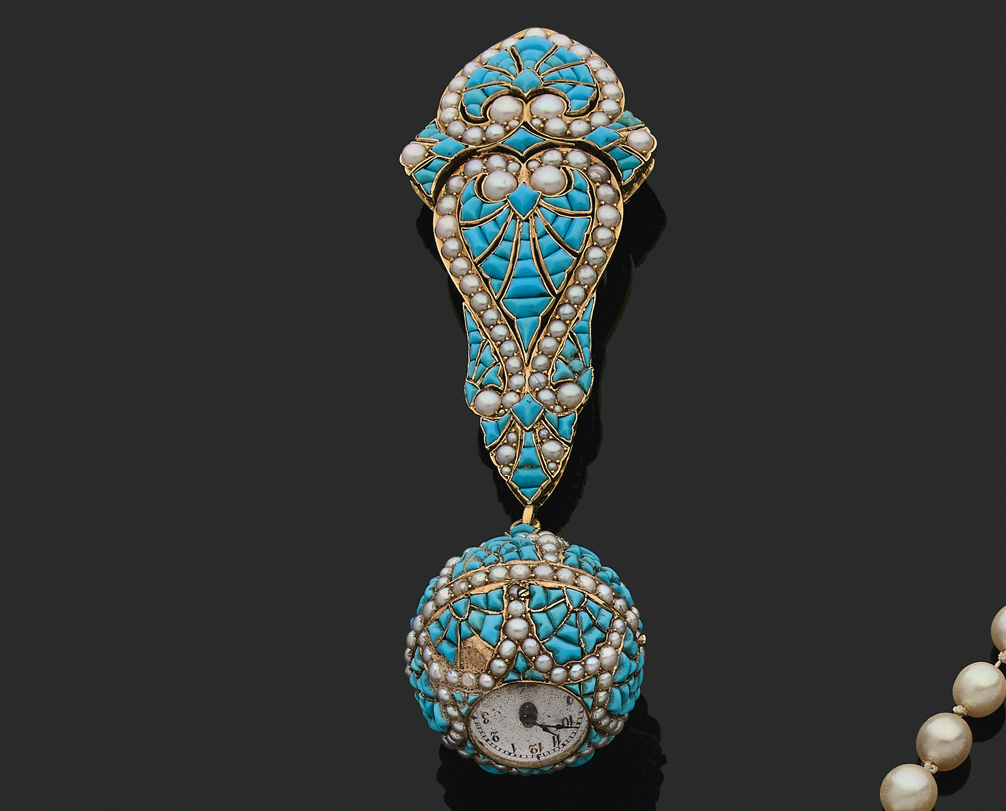
Ladies’ pendant watch known as a Boule de Genève with gold (750 ‰) brooch, with scroll decoration, entirely paved with turquoise cabochons and half pearls. Circa 1870. Sold for €7200 at Fraysse & Associés on 7 April 2022.
11- Which personality from your profession/sector would you like to meet?
MC: The Queen of England who has one of the largest art collections in the world.
DB: I would have loved to meet Jeanne Toussaint, the artistic director of Cartier in 1933, and see how she worked with the teams and found her sources of inspiration. What a talent!
12- And to conclude, what advice would you give me on how to get started in this profession and achieve your full potential?
MC: You have to be curious, open to opportunities and specialise in one area
DB: Be curious, honest and culturally nourished on all subjects because in one way or another, it is always useful.
FD: I don’t have any advice to give. There are as many paths as there are people; stay curious!
See you soon!
